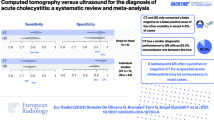Abstract
Background
Prior studies have examined the use of liver function tests (LFT) for predicting the presence of common bile duct (CBD) stones in chronic cholecystitis (CC) patients. It is currently unclear whether LFT are also useful for predicting CBD stones in patients with acute cholecystitis (AC).
Methods
Of 1059 patients who visited an emergency room with gallbladder-related symptoms between March 2004 and December 2009, 854 patients were analyzed, and were divided into three groups (556 AC patients without CBD stones (AC – CBD), 98 AC patients with CBD stones (AC + CBD), and 200 CC patients without CBD stones). We compared the LFT values at admission and the changes in LFT values over time following admission among the three groups.
Results
The LFT values were significantly greater in the AC + CBD group than in the AC − CBD groups. Of all the LFT variables analyzed, γ-glutamyl transpeptidase was the most reliable variable for predicting the presence of CBD stones, with a sensitivity of 80.6 % and a specificity of 75.3 % at the cut-off level of 224 IU/L. The elevated LFT values decreased significantly from the start of the follow-up assessment to before cholecystectomy in the AC − CBD group, but were unchanged before stone removal in the AC + CBD group.
Conclusion
The LFT values on initial admission and the changes in LFT values over time are reliable predictors of CBD stones in patients with AC.



Similar content being viewed by others
References
Mitchell SA, Jacyna MR, Chadwick S (1993) Common bile duct stones: a controversy revisited. Br J Surg 80:759–760
Ko CW, Lee SP (2002) Epidemiology and natural history of common bile duct stones and prediction of disease. Gastrointest Endosc 56:S165–S169
Baron RL (1987) Common bile duct stones: reassessment of criteria for CT diagnosis. Radiology 162:419–424
Prat F, Meduri B, Ducot B et al (1999) Prediction of common bile duct stones by noninvasive tests. Ann Surg 229:362–368
Rijna H, Borgstein PJ, Meuwissen SG et al (1995) Selective preoperative endoscopic retrograde cholangiopancreatography in laparoscopic biliary surgery. Br J Surg 82:1130–1133
Folsch UR, Nitsche R, Ludtke R et al (1997) Early ERCP and papillotomy compared with conservative treatment for acute biliary pancreatitis. The German Study Group on Acute Biliary Pancreatitis. N Engl J Med 336:237–242
Tham TC, Lichtenstein DR, Vandervoort J et al (1998) Role of endoscopic retrograde cholangiopancreatography for suspected choledocholithiasis in patients undergoing laparoscopic cholecystectomy. Gastrointest Endosc 47:50–56
Collins C, Maguire D, Ireland A et al (2004) A prospective study of common bile duct calculi in patients undergoing laparoscopic cholecystectomy: natural history of choledocholithiasis revisited. Ann Surg 239:28–33
Yang MH, Chen TH, Wang SE et al (2008) Biochemical predictors for absence of common bile duct stones in patients undergoing laparoscopic cholecystectomy. Surg Endosc 22:1620–1624
Menezes N, Marson LP, Debeaux AC et al (2000) Prospective analysis of a scoring system to predict choledocholithiasis. Br J Surg 87:1176–1181
Shiozawa S, Tsuchiya A, Kim DH et al (2005) Useful predictive factors of common bile duct stones prior to laparoscopic cholecystectomy for gallstones. Hepatogastroenterology 52:1662–1665
Topal B, Van de Moortel M, Fieuws S et al (2003) The value of magnetic resonance cholangiopancreatography in predicting common bile duct stones in patients with gallstone disease. Br J Surg 90:42–47
Stain SC, Marsri LS, Froes ET et al (1994) Laparoscopic cholecystectomy: laboratory predictors of choledocholithiasis. Am Surg 60:767–771
Koo KP, Traverso LW (1996) Do preoperative indicators predict the presence of common bile duct stones during laparoscopic cholecystectomy? Am J Surg 171:495–499
Liu TH, Consorti ET, Kawashima A et al (2001) Patient evaluation and management with selective use of magnetic resonance cholangiography and endoscopic retrograde cholangiopancreatography before laparoscopic cholecystectomy. Ann Surg 234:33–40
Peng WK, Sheikh Z, Paterson-Brown S et al (2005) Role of liver function tests in predicting common bile duct stones in acute calculous cholecystitis. Br J Surg 92:1241–1247
Padda MS, Singh S, Tang SJ et al (2009) Liver test patterns in patients with acute calculous cholecystitis and/or choledocholithiasis. Aliment Pharmacol Ther 29:1011–1018
Indar AA, Beckingham IJ (2002) Acute cholecystitis. BMJ 325:639–643
Geraghty JM, Goldin RD (1994) Liver changes associated with cholecystitis. J Clin Pathol 47:457–460
Triger DR, MacIver AG, Gamlen TR et al (1976) Liver abnormalities and gallstones: a prospective combined clinical, histological and surgical study. Br J Surg 63:272–277
Trowbridge RL, Rutkowski NK, Shojania KG (2003) Does this patient have acute cholecystitis? JAMA 289:80–86
Chang CW, Chang WH, Lin CC et al (2009) Acute transient hepatocellular injury in cholelithiasis and cholecystitis without evidence of choledocholithiasis. World J Gastroenterol 15:3788–3792
Yokoe M, Takada T, Strasberg SM et al (2013) TG13 diagnostic criteria and severity grading of acute cholecystitis (with videos). J Hepato Biliary Pancreat Sci 20:35–46
Kiriyama S, Takada T, Strasberg SM et al (2013) TG13 guidelines for diagnosis and severity grading of acute cholangitis (with videos). J Hepato Biliary Pancreat Sci 20:24–34
Hammarstrom L, Ranstam J (1998) Factors predictive of bile duct stones in patients with acute calculous cholecystitis. Dig Surg 15:323–327
Neitlich JD, Topazian M, Smith RC et al (1997) Detection of choledocholithiasis: comparison of unenhanced helical CT and endoscopic retrograde cholangiopancreatography. Radiology 203:753–757
Acknowledgments
The authors appreciate the Seoul National University Hospital Medical Research Collaborating Center (MRCC) for statistical and methodological advice.
Author information
Authors and Affiliations
Corresponding author
Ethics declarations
Conflicts of interest
Nothing to declare.
Rights and permissions
About this article
Cite this article
Ahn, K.S., Yoon, YS., Han, HS. et al. Use of Liver Function Tests as First-line Diagnostic Tools for Predicting Common Bile Duct Stones in Acute Cholecystitis Patients. World J Surg 40, 1925–1931 (2016). https://doi.org/10.1007/s00268-016-3517-y
Published:
Issue Date:
DOI: https://doi.org/10.1007/s00268-016-3517-y




